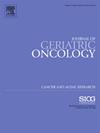基于电子健康记录的虚弱指标对老年非小细胞肺癌患者全因死亡率的预测价值。
IF 3
3区 医学
Q3 GERIATRICS & GERONTOLOGY
引用次数: 0
摘要
简介:虚弱程度筛查对于指导老年非小细胞肺癌(NSCLC)患者的治疗决策非常重要。然而,虚弱度测量(FMs)的效果仍不明确。本研究旨在评估基于临床环境中电子健康记录(EHR)数据的虚弱度指标对老年非小细胞肺癌患者全因死亡率的预后价值:我们利用韩国国立癌症中心的电子病历数据,对4253名年龄≥65岁、新诊断为NSCLC的患者(2007-2018年)进行了回顾性分析。虚弱程度通过实验室检查(基于常规实验室检查的虚弱指数[FI-Lab])、合并症和表现状态(电子虚弱指数[eFI])或两者(综合虚弱指数[FI-combined])进行测量。患者被分为虚弱和非虚弱两类。使用 Cox 比例危险模型和 C 指数来估计虚弱指数对诊断后 1 年、3 年和 5 年全因死亡率的预测能力,并对年龄、性别和 SEER 阶段进行调整:结果:基于电子病历的FMs可提高预测老年NSCLC患者生存期的预后能力。在所有人群中,FI-Lab 显示出最大的预测价值,尤其是对 1 年死亡率的预测价值,体弱组与非体弱组的调整后危险比为 2.25(95 % CI 2.02-2.51),C 指数为 0.74,而基础模型为 0.72(p-value):从电子病历数据中得出的易于使用的FMs可以提高对老年NSCLC患者全因死亡率的预测。肿瘤学家可以根据患者的病情,利用由合并症、功能状态和亚临床检验或 FI-Lab 组成的综合 FMs 来促进共同的癌症护理规划。本文章由计算机程序翻译,如有差异,请以英文原文为准。
Prognostic value of electronic health records-based frailty measures for all-cause mortality in older patients with non-small cell lung cancer
Introduction
Frailty screening is important to guide treatment decisions for older patients with non-small cell lung cancer (NSCLC). However, the performance of frailty measures (FMs) remains unclear. This study aimed to evaluate the prognostic value of FMs based on electronic health records (EHR) data in clinical settings for all-cause mortality in older patients with NSCLC.
Materials and Methods
We retrospectively analyzed 4253 patients aged ≥65 years, newly diagnosed with NSCLC (2007–2018) using EHR data from the National Cancer Center, Korea. Frailty was measured by either laboratory tests (frailty index based on routine laboratory tests [FI-Lab]), comorbidities and performance status (electronic Frailty index [eFI]), or both (combined frailty index [FI-combined]). Patients were categorized as frail or non-frail. Cox proportional hazards models and C-index were used to estimate the predictive ability of FMs for all-cause mortality in 1 year, 3 years, and 5 years post-diagnosis, adjusting for age, sex, and SEER stage.
Results
EHR-based FMs could enhance the prognostic ability to predict the survival of older patients with NSCLC. In the total population, FI-Lab showed the largest predictive value, especially for 1-year mortality with an adjusted hazard ratio for frail vs. non-frail groups of 2.25 (95 % CI 2.02–2.51) and C-index of 0.74 compared to 0.72 in the base model (p-value<0.001). FI-Lab could improve the prognostic ability for 1-year mortality in patients with regional and distant SEER stages and those receiving systemic therapy, whereas FI-combined could improve the prediction of 3-year and 5-year mortality in patients with localized disease and receiving surgery.
Discussion
Easy-to-use FMs derived from EHR data can enhance the prediction of all-cause mortality in older patients with NSCLC. Oncologists can utilize comprehensive FMs comprising comorbidities, functional status, and subclinical tests or FI-Lab, depending on the patient's medical condition, to facilitate shared cancer care planning.
求助全文
通过发布文献求助,成功后即可免费获取论文全文。
去求助
来源期刊

Journal of geriatric oncology
ONCOLOGY-GERIATRICS & GERONTOLOGY
CiteScore
5.30
自引率
10.00%
发文量
379
审稿时长
80 days
期刊介绍:
The Journal of Geriatric Oncology is an international, multidisciplinary journal which is focused on advancing research in the treatment and survivorship issues of older adults with cancer, as well as literature relevant to education and policy development in geriatric oncology.
The journal welcomes the submission of manuscripts in the following categories:
• Original research articles
• Review articles
• Clinical trials
• Education and training articles
• Short communications
• Perspectives
• Meeting reports
• Letters to the Editor.
 求助内容:
求助内容: 应助结果提醒方式:
应助结果提醒方式:


